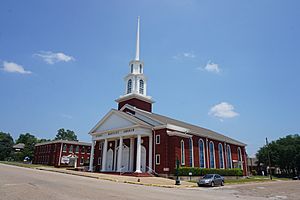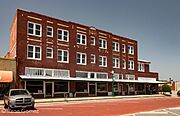Mineola, Texas facts for kids
Quick facts for kids
Mineola, Texas
|
|
|---|---|

Downtown Mineola
|
|

Location of Mineola, Texas
|
|
 |
|
| Country | United States |
| State | Texas |
| County | Wood |
| Incorporated (city) | 1877 |
| Area | |
| • Total | 10.45 sq mi (27.07 km2) |
| • Land | 10.28 sq mi (26.61 km2) |
| • Water | 0.18 sq mi (0.46 km2) |
| Elevation | 338 ft (103 m) |
| Population
(2020)
|
|
| • Total | 4,823 |
| • Density | 463.84/sq mi (179.09/km2) |
| Time zone | UTC−6 (Central (CST)) |
| • Summer (DST) | UTC−5 (CDT) |
| ZIP Code |
75773
|
| Area code(s) | 430, 903 |
| FIPS code | 48-48648 |
| GNIS feature ID | 2411118 |
| Website | www.Mineola.com |
Mineola is a city in Wood County, Texas. It is located about 26 miles north of Tyler. In 2020, about 4,823 people lived there.
The town became an official city in 1877 when railroads arrived. A railroad official named Ira H. Evans created the name "Mineola." He combined the names of his daughter, Ola, and her friend, Minnie Patten.
Contents
History of Mineola
Mineola started because of the railroads in 1873. Two big railroad companies, the Texas and Pacific and the International-Great Northern, raced to reach Mineola first. The International-Great Northern won by just 15 minutes!
The city government began in 1873. A post office opened in 1875, and the town became an official city in 1877. In the 1880s, a fire destroyed many buildings. The town's oldest newspaper, the Mineola Monitor, started in 1876. By 1890, Mineola had churches, schools, hotels, and banks. About 2,000 people lived there. In 1895, Mineola hosted the Wood County Fair.
Mineola was in the middle of a big timber area. This meant there was plenty of wood for railroad ties and lumber. For the first 60 years, farmers grew cotton, raised animals, and harvested fruits and berries. A factory that made chairs opened in 1886. It later made crates and baskets until 1952.
The town grew in the 1920s because of better highways and a new gas pipeline. In the 1940s, oil was found nearby, and a railroad repair shop was built. These things helped the economy. By 1930, the population was 3,000, and by 1970, it was 4,000.
By 1950, farmers mostly raised cattle and grew watermelons. The Mineola Watermelon Festival started in 1948. Other businesses like sweet potato farms, a creamery, and a company that supplied wood also helped the economy.
Mineola is still an important shipping center. The Mineola Memorial Library opened in 1960. Lake Holbrook, built in 1962, is a popular spot for people to visit. The Meredith Foundation has given a lot of money for education and culture since 1962. The Meredith Hall Civic Center, finished in 1977, is used for many events. In 1980, Mineola had 4,346 people.
Today, many people work in factories that make clothes, sporting goods, and electronics. They also make fertilizer and cattle feed. Some companies package dry beans and meat. The Wood County Airport, built in 1984, is just five miles north of Mineola. A new city hall opened in 1986, and a new school facility in 1987. In 1990, the population was 4,321.
Geography and Climate
Mineola is located at 32.652881 degrees North and -95.480296 degrees West. The city covers about 10.3 square miles. Most of this area is land, with a small part being water.
Mineola's Weather
Mineola has weather typical of East Texas. This means it can be unpredictable, especially in the spring. The climate is called a humid subtropical climate. This is common in the southeastern United States.
Population and People
Mineola's population has grown over the years:
| Historical population | |||
|---|---|---|---|
| Census | Pop. | %± | |
| 1880 | 1,175 | — | |
| 1890 | 1,333 | 13.4% | |
| 1900 | 1,725 | 29.4% | |
| 1910 | 1,706 | −1.1% | |
| 1920 | 2,299 | 34.8% | |
| 1930 | 3,304 | 43.7% | |
| 1940 | 3,223 | −2.5% | |
| 1950 | 3,626 | 12.5% | |
| 1960 | 3,810 | 5.1% | |
| 1970 | 3,926 | 3.0% | |
| 1980 | 4,346 | 10.7% | |
| 1990 | 4,321 | −0.6% | |
| 2000 | 4,550 | 5.3% | |
| 2010 | 4,515 | −0.8% | |
| 2020 | 4,823 | 6.8% | |
| U.S. Decennial Census | |||
Here's a look at the different groups of people living in Mineola in 2020:
| Race | Number | Percentage |
|---|---|---|
| White (NH) | 3,081 | 63.88% |
| Black or African American (NH) | 453 | 9.39% |
| Native American or Alaska Native (NH) | 17 | 0.35% |
| Asian (NH) | 31 | 0.64% |
| Some Other Race (NH) | 3 | 0.06% |
| Mixed/Multi-Racial (NH) | 146 | 3.03% |
| Hispanic or Latino | 1,092 | 22.64% |
| Total | 4,823 |
In 2020, there were 4,823 people living in Mineola. There were 1,686 households and 1,021 families. About 29.2% of households had children under 18. The average household had 2.48 people. The average family had 3.08 people.
The median age in Mineola was 39.1 years. This means half the people were younger than 39.1, and half were older.
Places of Worship
Mineola has several churches:
- First Baptist Mineola is one of the largest churches in the Wood County area. It has about 850 members.
- Sand Springs Baptist Church is just west of Mineola. About 350 people attend on Sundays.
- Broad Street Church of Christ
- Mineola First United Methodist Church
- New Hope Baptist Church
- St. Paul Missionary Baptist Church, started in October 1871
- Johnson Chapel United Methodist Church
- Sidney Temple Church of God
- East Chapel Christian Methodist Episcopal Church
- St. Peter the Apostle Roman Catholic Church is part of the Roman Catholic Diocese of Tyler.
Sports in Mineola
The Mineola Black Spiders were a famous African-American baseball team. They played exhibition games, traveling to different places. In 2010, the Texas Historical Commission put up a historical marker for them.
Fun Places and Parks
Mineola has many places for fun and relaxation:
- The Mineola Nature Preserve is the largest city-owned park per person in the United States. It covers 2,911 acres. It was created in 2005 and is known as "The Birding Capital of East Texas."
- Howard L. and Vivian W. Lott House is a special house with unique architecture. It is recognized as a Texas Historic Landmark. It is also listed on the National Register of Historic Places.
- Iron Horse Square is a five-acre park in downtown Mineola. It celebrates the city's railroad history. The park has a mini train, a railroad-themed playground, and a historical walking trail.
- Mineola Downtown Historic District has many old buildings built between 1885 and 1960. This area covers almost 23 acres. It was added to the National Register of Historic Places in 2013.
- Lakes:
- Lake Holbrook is four miles west of Mineola.
- Lake Fork is 20 miles north. It is between the towns of Quitman, Alba, Emory, and Yantis, Texas.
Education in Mineola
Students in Mineola attend schools in the Mineola Independent School District.
- Mineola High School
- Mineola Colored High School (a historic school)
- McFarland Elementary
Local Media
Newspaper
The Wood County Monitor is a weekly newspaper. It serves Mineola and Wood County. In 2016, the Mineola Monitor and the Wood County Democrat newspapers joined together to form the Wood County Monitor.
Radio
KMOO-FM (99.9 MHz FM) is a local radio station. It plays country music. The station is licensed to Mineola, Texas, and serves the Tyler-Longview area.
Getting Around Mineola
Roads
Mineola is where two major U.S. highways meet: US 69 and US 80. These roads cross in the downtown area. Texas Highway 37 also connects Mineola and Quitman.
- Major highways
- Farm to market roads
- State highways
Railroads
Mineola is served by Amtrak's Texas Eagle passenger train line. The railroad tracks that go through Mineola are owned and run by Union Pacific.
Airports
Mineola has two airports:
- Mineola Wisner Field (also called 3F9) started in 1917. The same family has owned it since 1926.
- Wood County Airport (Mineola/Quitman Airport) is a public airport owned by Wood County.
Gallery
Famous People from Mineola
Many interesting people have connections to Mineola:
- Willie Brown, a former mayor of San Francisco, went to Mineola Colored High School.
- R.C. Hickman, a photographer who documented the Civil Rights Movement in the 1950s.
- Jim Hogg, a Texas governor, lived in Mineola. His daughter, Ima Hogg, was born there.
- Bryan Hughes, a member of the Texas House of Representatives and the Texas State Senate.
- Bobby Ray Inman, a former deputy director of the CIA.
- Adam Moore, a professional baseball player.
- Kacey Musgraves, a Grammy-winning country music singer and performer.
- Jack Rhodes, an important country music songwriter who is in the Nashville Songwriters Hall of Fame.
- Noble Willingham, an actor known for movies like The Last Picture Show and the TV show Walker, Texas Ranger.
See also
 In Spanish: Mineola (Texas) para niños
In Spanish: Mineola (Texas) para niños








